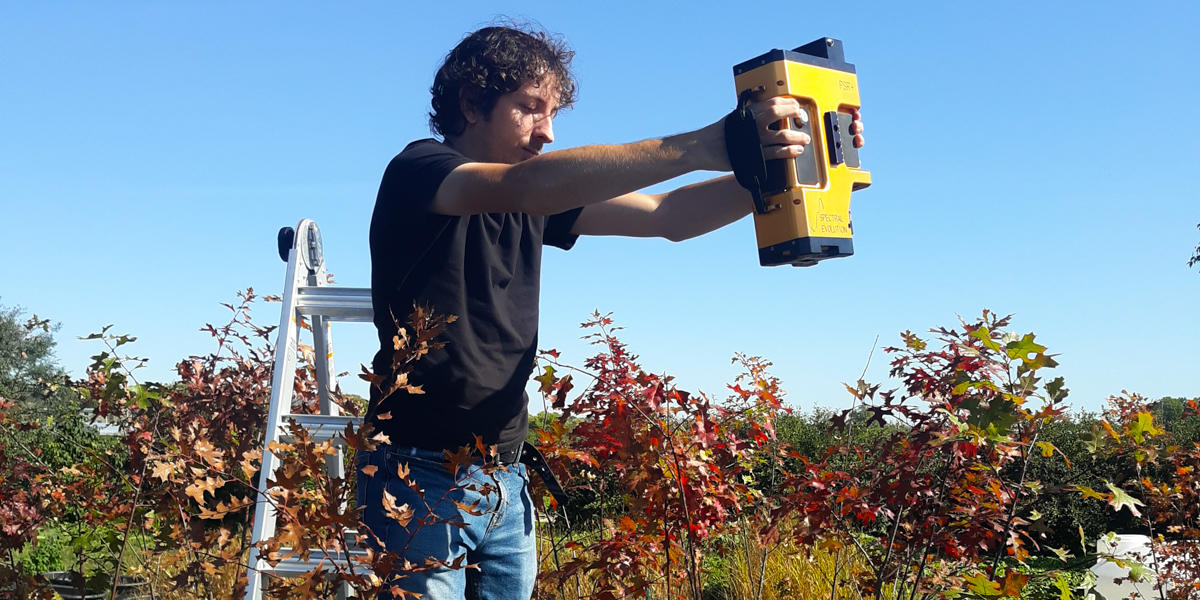
Gerard Sapés, PhD, uses a portable spectroradiometer to gather information from oak tree saplings
Background
More than 266,000 oak trees were infected by oak wilt fungus between 2007 and 2016 in Minnesota, making it the second greatest invasive pathogen threat to the state behind Dutch elm disease. The fungus is found in more than a quarter of all Minnesota counties.
Early and accurate detection of oak wilt is key to stopping its spread. Researchers on this project explored the diagnostic potential of hyperspectral imaging, a remote sensing technology, capable of surveying a scene or landscape and extracting detailed information about its features. It may be sensitive enough to identify oak wilt before visible signs of infection and help managers differentiate between trees exhibiting oak wilt and those suffering from drought or other diseases.
Most management programs promote root cutting between diseased and healthy oaks to prevent disease spread. The preferred tool for this step in Minnesota is the vibratory plow line. Researchers tested long-standing assumptions about this management practice.
Project phases
Research project title: Accurate detection and integrated treatment of oak wilt (Bretziella fagacearum) in Minnesota
Taxa: Pathogen
Species: Oak wilt (Bretziella fagacearum)
Project status: Completed in 2021
Funding: $357,420
Research questions
- How can hyperspectral imagery technology be used to detect oak wilt at the leaf, tree crown and forest stand levels?
- How can we improve root cutting protocol to stop the below-ground spread of oak wilt fungus?
Research project title: Accurate detection of oak wilt disease from tree to landscape scales for enhanced forest management
Taxa: Pathogen
Species: Oak wilt (Bretziella fagacearum)
Project status: Completed in 2023
Funding: $299,112
Research questions
- What models and tools are best to detect and differentiate oak wilt from other damage at multiple scales?
- What is the efficacy of an improved oak wilt treatment method in a long-term field experiment, comparing current and proposed approaches? What are the costs of the two approaches?
Outcomes
Cavendar-Bares’ team developed methods and approaches to detect oak wilt infection at the leaf and canopy level, and landscape level and regional level, using spectral biology. Using hand-held, drone-based, airborne, and spaceborne sensors to capture reflected photons from trees, they detected spectral signatures of oak wilt disease by applying a series of modeling approaches.
Through several experiments indoors and outdoors, their combined project results highlight the capabilities of spectral measurements from satellite, aircraft, drones, and handheld devices to detect oak wilt at vastly different spatial scales, differentiate it from other kinds of stress such as drought and bur oak blight, and map it at fairly high accuracy. These outcomes benefit forest managers in Minnesota and beyond.
In addition, the research team documented oak wilt management best practices to prevent the spread of oak wilt using the two-pass vibratory plow protocol.
Publications
- Mechanistic links between physiology and spectral reflectance enable previsual detection of oak wilt and drought stress (Proceedings of the National Academy of Sciences of the United States of America, 2024). The accepted manuscript is available to read for free.
- Mapping oak wilt disease from space using land surface phenology (Remote Sensing of Environment, 2023)
- Canopy spectral reflectance detects oak wilt at the landscape scale using phylogenetic discrimination (Remote Sensing of Environment, 2022)
- Spectral differentiation of oak wilt from foliar fungal disease and drought is correlated with physiological changes (Tree Physiology, 2020)
Outreach
- Recording of presentations at the Invasive Species Forum, 2024
- National meetings with the US Forest Service and the National Park Service, 2023
- NASA Carbon Cycle & Ecosystems Joint Science Workshop, 2023
- NASA's Biodiversity and Ecological Forecasting meetings
- University of Minnesota Office of Vice President for Research Research Workshop, 2023
- SDG Webinar
- International Workshop on Sapflow
- American Geophysical Union
- 3-day presentation at the Minnesota State Fair, 2022
- Upper Midwest Invasive Species Conference, 2022
- Recording of presentation at Drones in Invasive Species Management (video), a symposium hosted by MITPPC, 2019
News and media
- Beam me up Scotty! A plain language summary of the process of using spectral reflectance to detect oak wilt and drought in oak trees (blog of Gerard Sapés, 2024)
- Innovative detection system allows researchers to differentiate oak wilt and drought (MITPPC, 2023)
- Innovations for oak wilt detection and containment (MITPPC, 2023)
- UMN researchers use satellite data to aid in preventing the spread of oak wilt disease (MN Daily, 2023)
- Mapping deadly oak wilt disease from space to protect our forests (Phys.org, 2023)
- Mapping deadly oak wilt disease from space to protect our forests (2023)
- Fungus among us (original video, YouTube, 2021)
- UMN researchers say invasive fungus that threatens oak trees is spreading (The Minnesota Daily, 2020)
- Cross-disciplinary research teams seek to answer grand challenges in biology (National Science Foundation, 2020)
- Saving America's Tree: Oak Wilt Early Detection in Minnesota (Minnesota Invasive Terrestrial Plants and Pests Center, 2019)
- The spectral diversity of plants (Nature Ecology & Evolution Community, 2018)
- 5 Ways Researchers Are Using Drones to Stop Invasive Species (Minnesota Invasive Terrestrial Plants and Pests Center, 2019)
- Meet the Researcher: Gerard Sapés